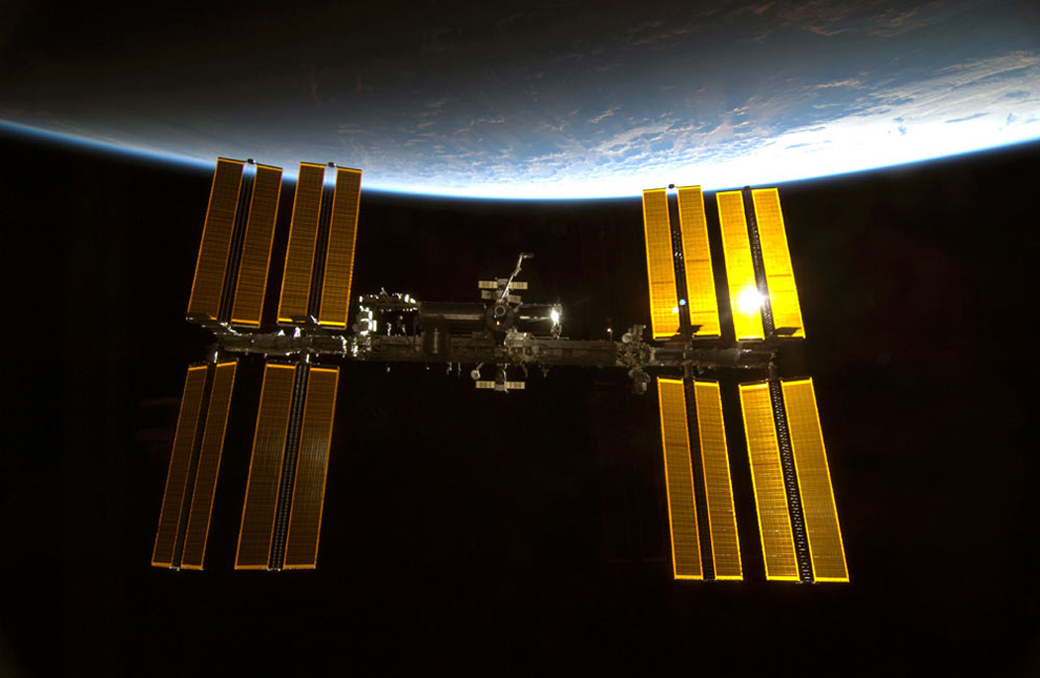Astronauts Excited For First Yearlong Trip to International Space Station

The two men preparing for the first-ever yearlong mission to the International Space Station are looking forward to the challenge, they said today (Dec. 5).
Friends and family are supportive of the mission, said astronaut Scott Kelly, though perhaps none more so than his 9-year-old daughter.
"When I told her on the phone that I was going to spend a year on the space station, she screamed out, 'Awesome!'" Kelly said today during a press conference at NASA's Johnson Space Center in Houston.
Kelly and Russian Federal Space Agency cosmonaut Mikhail Kornienko are due to launch on the yearlong mission in 2015.
The flight is designed to help scientists understand how the human body adapts to spaceflight longer than six months, the usual length of stints aboard the space station. [Most Extreme Human Spaceflight Records]
No one has ever spent a continuous year on the International Space Station (ISS), though four Russian cosmonauts have experienced nearly year-long or longer missions in low-Earth orbit. One, Valery Polyakov, stayed aboard the Russian space station Mir for 428 consecutive days in 1994 and 1995.
All of these cosmonauts flew in the early era of spaceflight, said ISS program scientist Julie Robinson. The last long-duration mission ended in 1999. Kelly Kornienko will become the first people since then to spend a year in orbit.
Breaking space news, the latest updates on rocket launches, skywatching events and more!
Testing the human body
NASA and other space agencies know a lot about how the body responds to six months in space, Robinson told reporters, but little about what happens next — though that sort of knowledge is crucial as agencies contemplate sending humans back to the moon, to an asteroid, or to Mars.
NASA has several major concerns about the health effects of long-duration spaceflight. One of the most pressing is a recently discovered side effect: vision problems created by increased pressure in the skull in microgravity. Researchers aren't yet sure if some of those vision changes might be permanent, Robinson said.
Kelly and Kornienko will also act as guinea pigs in studies to see how a year in space affects immune system function, bone loss, radiation exposure and psychological functioning, as well as difficulties adapting back to Earth's gravity when they return. These issues are well-understood in the six-month timeframe, Robinson said, but there are questions about whether some effects will worsen over time.
The yearlong mission will also require a shift in training for Kelly and Kornienko, who will be part of six consecutive crews during their time away from Earth. They'll first be a part of a three-member crew in the Soyuz spacecraft that takes them up to the space station, said Robert Behnken, NASA's chief astronaut. When that Soyuz craft leaves, Kelly and Kornienko will remain on the station as four different ISS crews arrive and leave. Finally, they'll join a third person to end the mission on their return to Earth.
The two men will participate in the daily activities of the orbiting laboratory, including spacewalks, making them "no different than anyone else who flies on the International Space Station," Kelly said.
Far from home
Both Kelly and Kornienko said they looked forward to their yearlong voyage, though neither was naïve to the challenges ahead.
"It's definitely a challenge," Kelly said. "I think in a lot of ways it will be similar to those challenges that people do that are kind of considered type-two fun. It's fun when you're done with it, not while you're doing it, like climbing Mount Everest."
The rigors of preparing for the mission will keep both Kelly and Kornienko busy even before their launch, scheduled for March 2015. Kornienko is beginning a six-month training stint in Houston, putting him far from his family long before he heads to space.
"My wife, of course, she started to cry. That was her reaction," to hearing Kornienko would be taking the yearlong assignment, he said.
Kornienko and Kelly will have the ability to chat with friends and family on the ground from the station, an opportunity that would be available with less frequency for astronauts headed to Mars or another far-flung location. Kelly, who lived on the ISS for a six-month mission between 2010 and 2011, said he'll spend more time on this mission planning out entertainment and coping mechanisms.
Kelly also said his previous six-month mission gave him an unwelcome look at how he'd respond if something tragic were to happen on the ground to friends or family while he is in space. On Jan. 8, 2011, Kelly's sister-in-law, then-congresswoman Gabrielle Giffords (wife of Kelly's twin brother, Mark Kelly, who is also an astronaut, now retired), was shot in the head in Tucson. It was two months before Kelly returned to Earth and was able to see his family and the recovering Giffords.
"For me, it was a pretty significant event when my sister-in-law was shot along with all those other folks who were killed," Kelly said. "And you know, there is certainly nothing good comes out of anything like this, but as a result I do know how I respond to something along those lines. I don't know if it's helpful but if something, God forbid, something tragic was to occur I kind of know how I would react."
Follow Stephanie Pappas on Twitter @sipappas or LiveScience @livescience. We're also on Facebook & Google+.

Stephanie Pappas is a contributing writer for Space.com sister site Live Science, covering topics ranging from geoscience to archaeology to the human brain and behavior. She was previously a senior writer for Live Science but is now a freelancer based in Denver, Colorado, and regularly contributes to Scientific American and The Monitor, the monthly magazine of the American Psychological Association. Stephanie received a bachelor's degree in psychology from the University of South Carolina and a graduate certificate in science communication from the University of California, Santa Cruz.


